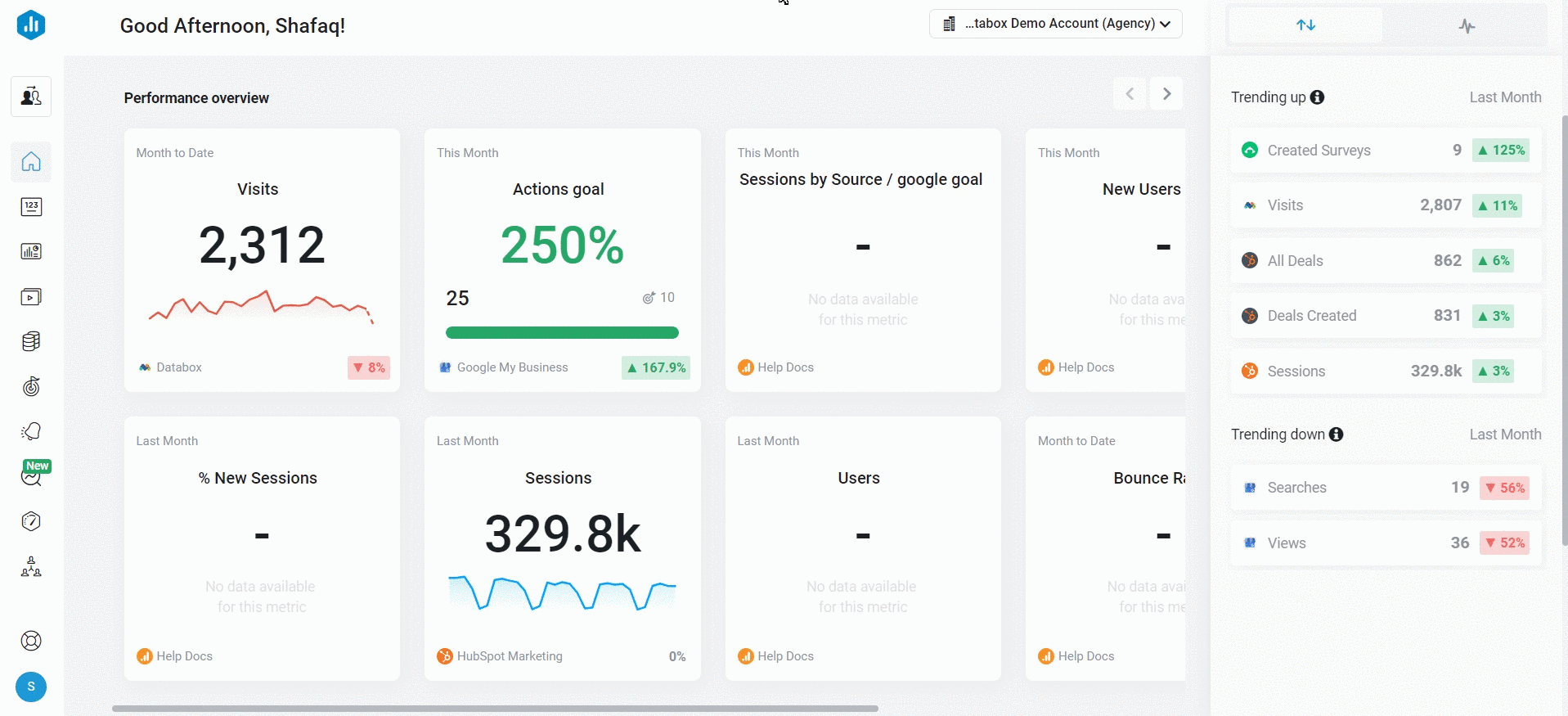Guide: Using X (Twitter) with Databox
HOW TO
- Connect X (Twitter) to Databox
- Access pre-built X (Twitter) Templates
- Build a Databoard using X (Twitter) data
- Additional Information
How to connect X (Twitter) to Databox
IN THIS SECTION
- What’s the maximum amount of historical data initially available when you use a new X (Twitter) Metric in Databox?
- What time zone does X (Twitter) data sync in?
How to connect X (Twitter) to Databox

To connect a Twitter Account in Databox, go to Data Manager > + New connection. Type X (Twitter) in the search bar and click on the green Connect button.
This will open the Authorization window, which is where you will be prompted to enter your Twitter login credentials and authorize the Databox app.
What's the maximum amount of historical data initially available when you use a new X (Twitter) Data Source Metric in Databox?
When you connect a new X (Twitter) Data Source to Databox, no historical data is initially synced. Data is synced for the Metrics that are being used in your Account, so when you first use a new X (Twitter) Metric, data will start to sync.
Certain Metrics may have more or less historical data available based on API restrictions. For more information about the amount of historical data available for a specific Metric, please contact our Support Team at help@databox.com.
Pro Tip: In order to start syncing data for a Metric, you can add it to your Metrics screen, use it in a Scorecard, set a Goal around it, create an Alert for it, or add it to a Databoard. Learn more here.
The amount of historical data you're able to access in Databox is dependent on your Databox plan. Learn more here.
What time zone does X (Twitter) data sync in?
X (Twitter) data is synced in the UTC.
How to access pre-built X (Twitter) Templates

- Navigate to Databoards > Public Templates
- In the Data Source drop-down list, select X (Twitter)
- To view a preview of the Template populated with dummy data, click Preview
- To pull the Template into your Account and re-populate it with your own X (Twitter) data, click Use Template
-
Select the appropriate X (Twitter) Data Source from the drop-down list to complete the process. The Databoard will be re-populated with data from the selected X (Twitter) Account and can be found on the Databoards page
Pro Tip: Once the Databoard is available on the Databoards page, it is completely disconnected from the public Template. Therefore, you can further customize this Databoard to meet your specific needs using the Designer.
Popular X (Twitter) Templates
| Account Overview |
|---|

|
X (Twitter) Account Overview Template will help you gather information on your Followers, Tweets, Retweets, and Mentions.
|
How to build a Databoard using X (Twitter) data
IN THIS SECTION
Popular X (Twitter) Metrics
|
Followers |
Tweets |
Mentions |
|---|---|---|
|
|
|
|
View a full list of X (Twitter) Metrics available in Databox here.
How to build a Databoard

- Navigate to Databoards > + New Databoard > Start Blank.
-
Click on the Metric Library icon on the lefthand side of the Designer.
-
Select the appropriate X (Twitter) Account from the Data Source drop-down list in the Metric Library.
-
View the list of pre-built X (Twitter) Datablocks in the Metric Library. Drag and drop your selected Datablock onto your Databoard.
- If a pre-built Datablock isn't available for your use case, click on the Visualization Types icon under the Metric Library icon.
- View the list of Visualizations available in Databox. Drag and drop your selected Visualization onto your Databoard.
-
Click on the Datablock on the Databoard to open the corresponding Datablock Settings on the righthand side of the Designer.
- Select the appropriate X (Twitter) Data Source and Metric in the righthand Datablock Settings. This will update the Datablock, and it will populate the Datablock with the corresponding data.
- Complete steps 4-8 until your Databoard is complete.
Additional Information
IN THIS SECTION
Metric Considerations
- "New Tweets,'' ''Recent Tweets by Retweets,'' and ''Recent Tweets by Likes'' report on the most recent 200 tweets.
- ''10 Recent Followers by Follow Count'' returns a maximum of 10 followers.
- X (Twitter) allows users to have more than one Tweet with the same title. When syncing this data with Databox, this resulted in all values being pushed to the same 1 Tweet.
- To ensure accurate reporting for unique Tweets, a timestamp has been added to each Tweet in Databox. This timestamp represents the date when the Tweet was published.
- Tweets are now displayed as follows in Databox: ''Tweet (mm/dd/yy hh:mm:ss).'' For example, ''Spring Stock-Up Sale Reminder (02/02/2018 23:37:29),'' rather than just ''Spring Stock-Up Sale Reminder.''
- This applies to the Metrics ''New Tweets by Retweets Count'' and ''New Tweets by Likes Count.''
- We can only sync tweets that have been created in the last 7 days. Meaning, if you have Last Month selected in Databox, we will be able to retrieve only retweets from the last 7 days of the month. Unfortunately, due to API limitations we can't provide more accurate historical data for "Retweets", "Mentions" and "Replies" metrics. Therefore, we advise you to use more recent Date Ranges to report on historical data.
How to verify New Tweet data in Databox vs X (Twitter)?

Granularity Restrictions
- Due to API limitations, hourly granularity is not supported. This may affect visualization options for Charts in Databox.
For example, if an X (Twitter) Metric is used on a Line or Bar Chart with ''Yesterday'' Date Range selected, hourly data won't be displayed on the Chart.
However, the big number above the Chart will accurately reflect the Metric value for the selected Date Range.
Learn more about Granularity here.


